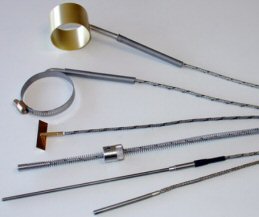|
Product overview |
|
|
|
![]()
|
There are many types of temperature sensors that will use various technologies and have different shapes. These sensors are used in many fields in the industry and in household equipment. Appliances (ovens, refrigerators…), cars (engine, car interior), processing industries (plastic, food, chemical, car, electronics industries …), domestic and industrial heating facilities. |
 |
Among the various types of temperature sensors are thermocouples and resistor sensors:
- Thermocouples generate an electromotive force (mV) when temperature of “hot weld” of thermocouple (which is in contact with heat source) is different from temperature of “cold weld” (the “cold weld” being the benchmark) . This value corresponds with a temperature according to international standards. An electronic device conGreens this value into a temperature in order to display it (temperature indicator) or regulate it (temperature regulator). There are J type thermocouples (iron/constantan), K type thermocouples (nickel chromium / aluminium plated nickel), S type thermocouples (platinum /rhodium plated platinum), etc …
- Resistor sensors use variations of resistivity of materials according to temperatures. To the measured value corresponds a temperature according to international standards. Data are collected by a temperature indicator or a temperature regulator. Among resistor sensors are the standardized PT100 platinum sensor, thermistor sensors, etc…
The vast majority of recent regulators can work with thermocouples (J, K, …) or resistor sensors (PT100) after being set up adequately.
![]()
![]() Operating temperature range :
Operating temperature range :
The operating temperature range of thermocouples and platinum sensors is shown in below table. The adequate type of temperature sensor will be selected depending on operating temperature and application (see various types).
|
type |
Positive |
Negative |
Temperature range |
|
J Thermocouple |
Iron |
Constantan |
0° C / +760° C |
|
K Thermocouple |
Nickel chromium |
Aluminium plated nickel |
0° C / +1260° C |
|
PT 100 |
|
|
-200°C / +850°C |
![]()
![]() Color codes :
Color codes :
Color codes enable someone to identify the type of thermocouple that is being used, together with international or national standards applied and polarity of each thermocouple wire. As standard, we would use the international norm.
J type thermocouple :
| Polarity | IEC 584* (International) |
AFNOR(France) | DIN(Germany) | ANSI(USA) | |
| Iron | + | Black | Yellow | Red | White |
| Constantan | - | White | Black | Blue | Red |
![]()
| Polarity | IEC 584* (International) |
AFNOR(France) | DIN(Germany) | ANSI(USA) | |
| Nickel chromium (Chromel) | + | Green | Yellow | Red | Yellow |
| Aluminium plated nickel (Alumel) | - | White | Violet | Green | Red |
![]()
![]() Platinum sensor : :
Platinum sensor : :
Connecting diagram:
![]()
![]() Tolerances :
Tolerances :
Thermocouples (Class 2):
| Thermocouples | |
| J | ±2.5°C (±4.5°F) from 0 to 330°C (32 to 626°F) ±0.75 % from 330°C to 760°C (626 to 1400°F) |
| K |
±2.5°C (±4.5°F) from 0 to 330°C (32 to 626°F) ±0.75 % from 330°C to 1260°C (626 to 2300°F) |
100 W at 0°C (32°F) Platinum Sensor (Class B) :
Temperature °C Tolerance
IEC 751:1983 (NF C 42-330, DIN 43790, BS 1904)CLASS A CLASS B ± C° ± Ohms ± C° ± Ohms -200 0.55 0.24 1.3 0.56 -100 0.35 0.14 0.8 0.32 0 0.15 0.06 0.3 0.12 100 0.35 0.13 0.8 0.30 200 0.55 0.20 1.3 0.48 300 0.75 0.27 1.8 0.64 400 0.95 0.33 2.3 0.79 500 1.15 0.38 2.8 0.93 600 1.35 0.43 3.3 1.06 650 1.45 0.46 3.6 1.13 700 - - 3.8 1.17 800 - - 4.3 1.28 850 - - 4.6 1.34
